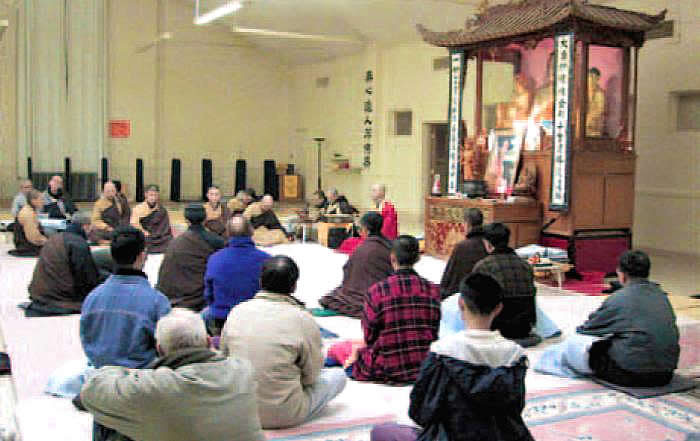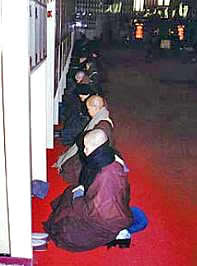 |
|
 |
Winter Chan Meditation
There are different meditational methods taught by the Buddha and the Buddhist Patriarchs. These methods are for calming, concentrating, and purifying the mind. In the Chan School of Buddhism, the practice of meditation is foremost. The Patriarch Bodhidharma focused on teaching Chan.
is an abbreviation of “Chan-na.” In Sanskrit, it is called “Dhyana.”
The Chan Master Hsuan Hua advices:
"In the Dharma-door of investigating Chan, you must fix your attention on what you are doing. At all times, you should return the light and reflect within. Don't be too tense, and don't be too slack. It's said,
Too tight, and it'll break. Too slack, and it'll be loose. Neither tight nor slack, and it will turn out right.
But neither tense nor slack is the Middle Way. Walking, standing, sitting and lying down, don't be apart from this. Once you leave this, you have missed it. What is this? It's the ultimate meaning of the Middle Way..."

Just prior to the winter Chan session is the Amitabha Buddha recitation session in which participants were cultivating on being continuously mindful of the Buddha. And so, during the Chan session, a very common and popular meditation topic is: "Who is mindful of the Buddha?" While sitting in meditation and upon rising from the sitting position, one constantly investigates "Who is mindful of the Buddha?" One cultivates and holds this meditational enquiry in order to develop concentration and to prevent other random or idle thoughts from arising.
The Venerable Master Hsuan Hua explains:
Our restless mind is constantly looking for something to keep it busy. To set it at ease, we give it the task of reciting "Namo Amitabha Buddha." This is also a form of Dhyana meditation. You don't have to sit in lotus posture with your eyes closed, like Dhyana Master Linzi, to investigate Dhyana. You can also meditate with your eyes open.
Walking is Dhyana, sitting is Dhyana.
In speech or silence, movement or stillness,
One is always at peace.
One can investigate Dhyana whether moving or still, awake or asleep. An ancient saying goes:
With Dhyana and Pure Land, one is like a tiger with horns,
A teacher of humans in this life, a Patriarch or Buddha in the next.
With Dhyana but not Pure Land, nine out of ten go astray.
With Pure Land but not Dhyana, ten thousand cultivate and ten thousand go.The Venerable Master Hsuan Hua exhorts:
We forge our Vajra Bodies here in this great smelting furnace;
All Buddhas of the Ten Directions protect the Way-place;
Every Sage and Worthy One walked along this road.
And the Saha World will soon celebrate another Dharma-king.
In his lectures on the Shurangama Sutra, Venerable Master Hua clarifies:
"Dhyana,” also Sanskrit, is interpreted to mean “thought-cultivation” or “still consideration.” One uses the mind to trace the coming and going of thoughts, in much the same way as in the cultivation of “stopping and contemplating.” The Tian Tai school lists three stoppings which relate to the three contemplations: empty, false, and the middle. That teaching is basically a good one, but it is nothing compared to the Shurangama Samadhi. Dhyana can be ultimate or non-ultimate..."
In the Master's exposition on the Shastra on the Door to Understanding the 100 Dharmas, he explained "light ease" (one of the 11 wholesome dharmas) in this way:
"Eight, light ease, is an initial expedient in the cultivation of Chan samadhi. In the process of cultivation, before samadhi is actually achieved, one experiences a kind of light ease. Where does this state come from? It comes from being vigorous in cultivating wholesome dharmas and in stopping evil dharmas. Along with being vigorous in wholesome dharmas, one must vigorously abstain from greed, abstain from anger, and abstain from foolishness, practicing the three kinds of good roots discussed above. The resultant merit and virtue will manifest as a state of light ease, an incredibly comfortable feeling of both body and mind. Then, whenever one sits in meditation investigating Chan, one experiences an unsurpassed happiness, an extremely blissful state. That is what is meant here by light ease."
The 11 wholesome dharmas are:
1. faith;
2. vigor;
3. remorse;
4. shame;
5. absence of greed;
6. absence of anger;
7. absence of foolishness;
8. light ease;
9. non-laxness;
10. renunciation; and,
11. non-harming.Excerpts from the Venerable Master Hua's talk on "Chan, the Essence of all Buddhas":
The phrase "Who is mindful of the Buddha" is a regal, precious vajra sword. It is also the phrase "sweeping broom" recited by Kshudrapanthaka. Someone may say, "Why is it called both a regal, precious vajra sword and a sweeping broom? Since it is a regal, precious vajra sword, it can't be a broom. Since it is a broom, it can't be a regal, precious vajra sword." It depends which end you use. One end is a regal, precious vajra sword and the other end is a broom. One end, the regal, precious vajra sword, which can slice through gold and cut through jade, cuts through your emotions and severs your love. Being able to cut off ignorance and afflictions makes it a regal, precious vajra sword.
The broom end is like your mindfulness of "Who is mindful of the Buddha?" Just as each time you sweep the floor it gets a little cleaner, so too, sweeping with "who" sweeps away a lot of your lust. What the vajra sword cuts through is lust and what the broom sweeps away is also lust. It's your thoughts of desire, your emotional love, and other such problems. You can use the vajra sword to cut through all these unsolvable problems.
As soon as you investigate "who?" —the heavenly demons and externalists cannot do anything to you. There's no crack for them to slip through. That's because you are holding aloft the wisdom sword that subdues the ten great demonic armies. All the various demonic armies in this world will be conquered. None of the demons has any way to deal with your "who?" If you forget to be mindful of "who?" then there is a hole where the demons can wriggle their way in. That can happen because you put down your regal, precious vajra sword and give rise to ignorance.
When you investigate "Who is mindful of the Buddha?" things may get vague. You keep on investigating, but you can't find out "who?" Unable to find the "who," you give rise to a "feeling of doubt." Once this feeling of doubt arises, great doubt will bring great enlightenment. Small doubt will bring small enlightenment. No doubt will bring no enlightenment. Continual doubt will bring continual enlightenment. Brief doubt will bring brief enlightenment.
What is meant by a "feeling of doubt"? It's being unable to find out "who?" Hmm. "Who?" Sustained investigation of this word "who" for hours nonstop can bring you to the point that your breath ceases, your pulse stops, your thoughts come to a standstill, and you attain a profoundly great samadhi. With that kind of samadhi, you are in samadhi when you are walking; you are in samadhi when you are sitting; you are in samadhi when you are standing; and you are in samadhi when you are lying down. You neither enter it nor leave it, and so it's called a profoundly great samadhi. At that time, above, there will be no heaven; below, there will be no earth; in between, there will be no people; and afar, there will be no objects. Absolutely everything will be empty. Even emptiness will not exist.
Once emptiness is obliterated, what kind of state remains? Take a look. Think about it. Do you still have false thoughts? Do you still have extraneous ideas? When there isn't even any emptiness, where could the false thoughts and extraneous ideas be located? Where could lust be found? At that time, it's very easy to become enlightened. It's very easy to return to the root and go back to the source, to understand your mind and see your nature. When you understand your mind and see your nature, nothing that happens presents any difficulties; there are no obstructions. Once you see your nature, you never worry."
To read the entire Dharma talk, please click: Chan, the Essence of All Buddhas







